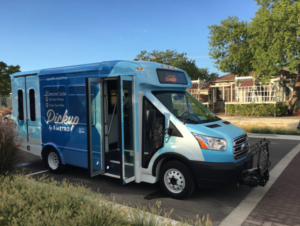Capital Metro to get close-up look at neighborhood circulators
Wednesday, October 30, 2019 by
Ryan Thornton In the face of ongoing regional sprawl, the Capital Metropolitan Transportation Authority is taking strides to connect low-density areas outside the city’s public transit network to its fixed-service routes.
The transit agency began that effort in June with an app-based pilot project serving the city of Manor. That program, Pickup, is now also available in four areas within the city of Austin that lack adequate access to fixed-service routes.
Capital Metro is now looking to improve its new neighborhood circulator service and has initiated a partnership with the Texas A&M Transportation Institute to help.

“We’re really making history,” Chad Ballentine, vice president of demand response and innovative mobility, said at Monday’s board meeting. “This is really the first time any transit authority has been doing a program like this at this volume.”
But as the service develops, Ballentine said the agency is “kind of reinventing the wheel” in determining how to measure and improve its performance. As a unique service, he said, neighborhood circulators require a different set of performance metrics than the traditional emphasis on ridership and adherence to a fixed schedule.
Ridership is still important, he said, and has grown from about 80 daily riders in late August to as many as 280 passengers today. But the agency has developed six alternative objectives it thinks can better guide the service moving forward: increasing access, expanding coverage, ensuring equity, continuing to innovate, and reaching both financial and environmental sustainability.
Those goals “cascade down to lots and lots of measurements,” Ballentine said, including some that are not easy to put a number to. The goal of the partnership with the institute will be to help the agency create a framework capable of measuring the success of those goals.
After about six months of testing and refining the specific metrics, Capital Metro will review the results and determine which goals are missing and which may need to be revised or discarded. The board will then see the result, a draft manual of service standards and guidelines, around summer of next year.
Throughout the process, the institute will also help evaluate each zone now being served by Pickup. By better understanding how the areas perform across the different categories, Ballentine said the agency will have a better idea of where else the service could be successful.
Board Member Eric Stratton said he is particularly interested to learn how Pickup can work in tandem with or as an alternative to MetroAccess for residents with disabilities and special health care needs.
“That’s the beauty here,” Ballentine said. Each Pickup vehicle is fully wheelchair accessible and every driver is trained for accessibility and passenger assistance. In addition, Pickup customers don’t need to schedule rides a day in advance as with MetroAccess. Besides that, he said, there may be a quality-of-life boost for those who would otherwise be segregated from the general population aboard MetroAccess.
The benefit of the service will be even greater in places like Leander, which Stratton said has not, “for all intents and purposes,” been served by MetroAccess over the past year. Pickup will be expanding to Leander in December.
CEO Randy Clarke said Pickup offers an opportunity to improve mobility in other smaller communities like Leander.
“There’s other communities … where people want to get around within the community itself and right now they have no service at all,” he said. “We’re thinking that lots of cities and towns will be coming and engaging with (us) over the next period of years because we’ll be able to provide this very cost-efficient but very great, almost … circulator type of service.”
Top photo by Ryan Thornton, inset courtesy of Capital Metro.
The Austin Monitor’s work is made possible by donations from the community. Though our reporting covers donors from time to time, we are careful to keep business and editorial efforts separate while maintaining transparency. A complete list of donors is available here, and our code of ethics is explained here.
You're a community leader
And we’re honored you look to us for serious, in-depth news. You know a strong community needs local and dedicated watchdog reporting. We’re here for you and that won’t change. Now will you take the powerful next step and support our nonprofit news organization?










